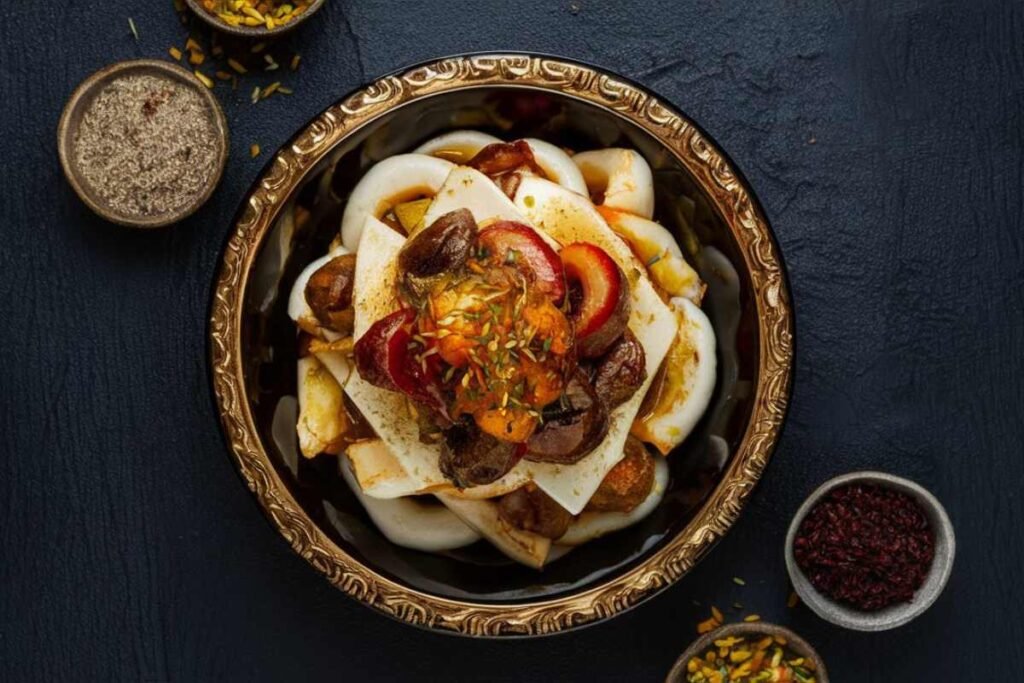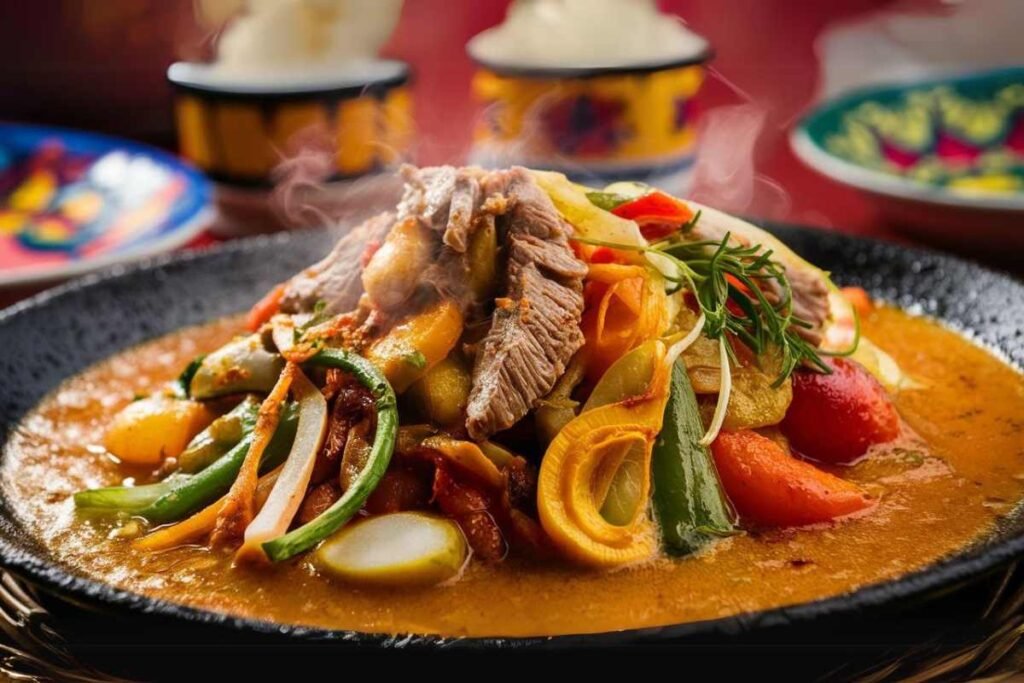Table of Contents
Introduction
Turkey, a country where East meets West, boasts a culinary tradition as rich and diverse as its history and culture.
At the heart of Turkish cuisine lies Çebiti, a culinary marvel that embodies the essence of Turkish hospitality and culinary craftsmanship.
Join us as we embark on a flavorful journey through the vibrant streets of Turkey and discover the tantalizing delights of Çebiti.
History of Çebiti

The roots of Çebiti can be traced back to the Ottoman Empire, a golden era of culinary innovation and refinement.
During this time, Çebiti emerged as a symbol of celebration and togetherness, gracing tables during festive occasions and family gatherings.
The dish was cherished for its hearty flavors and comforting warmth, bringing people together in times of joy and sorrow.
Over the centuries, Çebiti evolved, incorporating influences from various regions and cultures, yet retaining its timeless appeal and traditional charm.
Ingredients
At the heart of Çebiti lies a harmonious blend of ingredients, carefully selected to tantalize the taste buds and nourish the soul.
Tender cuts of lamb or beef, marinated in a fragrant symphony of spices, form the base of this culinary masterpiece.
Fresh vegetables, including tomatoes, bell peppers, and onions, add vibrant colors and textures, while aromatic herbs and seasonings infuse the dish with depth and complexity.
Rice, a staple of Turkish cuisine, serves as the perfect accompaniment, soaking up the savory juices and enhancing the overall flavor profile of Çebiti.
Preparation Method
The preparation of Çebiti is a labor of love, requiring patience, skill, and attention to detail. To begin, the meat is marinated overnight, allowing the flavors to meld and intensify.
Meanwhile, vegetables are chopped with precision, ensuring even cooking and optimal flavor distribution.
The key to perfecting Çebiti lies in slow cooking, as the dish is simmered gently until the meat is tender and the vegetables are soft and flavorful.
The result is a dish that is as visually stunning as it is delicious, a testament to the culinary expertise of Turkish cooks.
Cultural Significance
Beyond its gastronomic appeal, Çebiti holds profound cultural significance within Turkish society. It symbolizes hospitality, as families welcome guests with open arms and steaming bowls of Çebiti, showcasing their generosity and warmth.
Moreover, Çebiti serves as a link to the past, preserving age-old traditions and culinary techniques that have been passed down through generations.
Whether enjoyed at a wedding celebration or a cozy family dinner, Çebiti brings people together, fostering bonds and creating lasting memories.
Regional Variations
While Çebiti is beloved throughout Turkey, it’s worth noting that there are regional variations that add depth and diversity to this iconic dish.
In the Aegean region, for example, Çebiti is often prepared with an abundance of fresh seafood, reflecting the region’s coastal heritage.
In the southeastern region of Anatolia, Çebiti takes on a spicier flavor profile, with liberal use of chili peppers and aromatic spices.
These regional variations highlight the rich tapestry of Turkish cuisine and showcase the culinary diversity of the country.
Health Benefits
In addition to its delicious taste, Çebiti offers a myriad of health benefits thanks to its nutritious ingredients and wholesome preparation methods.
Lean cuts of meat provide high-quality protein, essential for muscle growth and repair, while fresh vegetables offer a bounty of vitamins, minerals, and antioxidants.
The use of aromatic spices not only enhances the flavor of Çebiti but also provides potential health benefits, such as anti-inflammatory and digestive properties.
Furthermore, the emphasis on seasonal, locally sourced ingredients promotes sustainability and environmental stewardship, making Çebiti a nourishing choice for both body and soul.
Culinary Innovation

While Çebiti is steeped in tradition, modern chefs and home cooks are constantly reimagining this classic dish, infusing it with new flavors, techniques, and ingredients.
From vegan variations made with hearty legumes and seasonal vegetables to fusion-inspired creations that blend Turkish flavors with international influences, there is no limit to the culinary creativity surrounding Çebiti.
These innovative adaptations ensure that Çebiti remains relevant and accessible to a diverse audience, while honoring its timeless heritage and cultural significance.
Cultural Celebrations
Çebiti plays a central role in Turkish cultural celebrations and festivities, serving as a symbol of abundance, hospitality, and communal sharing.
Whether it’s served at a traditional wedding ceremony, a religious festival, or a neighborhood street fair, Çebiti brings people together, fostering connections and creating a sense of unity and belonging.
The act of preparing and sharing Çebiti is a cherished tradition, passed down through generations and celebrated with joy and reverence.
Global Influence
As Turkish cuisine gains recognition on the global stage, so too does the popularity of Çebiti, attracting food enthusiasts from around the world eager to experience its unique flavors and cultural heritage.
With the rise of food tourism and culinary exploration, Çebiti has become a beloved symbol of Turkish gastronomy, celebrated for its authenticity, flavor, and tradition.
Whether enjoyed in a bustling Istanbul bazaar or a quaint countryside village, Çebiti leaves a lasting impression on all who taste it, forging connections and creating memories that transcend borders and cultures.
Recipe Adaptations
With the advent of digital media and online recipe-sharing platforms, Çebiti has found its way into kitchens worldwide, inspiring home cooks and professional chefs alike to put their own spin on this classic dish.
From simple weeknight suppers to elaborate dinner parties, Çebiti can be adapted to suit any occasion and dietary preference, making it accessible to a wide audience.
Whether it’s a traditional recipe passed down through generations or a modern interpretation infused with global flavors, Çebiti remains a versatile and beloved staple of Turkish cuisine.
Economic Impact
The popularity of Çebiti extends beyond the realm of culinary delight, contributing to the economic landscape of Turkey and supporting local farmers, producers, and businesses.
As demand for Turkish cuisine grows both domestically and internationally, Çebiti plays a vital role in attracting visitors and stimulating tourism, generating revenue for restaurants, hotels, and hospitality establishments.
Moreover, the global appeal of Çebiti creates opportunities for cultural exchange and collaboration, fostering connections and partnerships that benefit both the culinary industry and the broader economy.
Culinary Education
Çebiti serves as an invaluable educational tool for aspiring chefs and culinary enthusiasts seeking to learn about Turkish cuisine and culinary traditions.
Cooking classes, culinary workshops, and online tutorials offer hands-on experience in mastering the art of preparing Çebiti, providing insights into traditional cooking techniques, ingredient selection, and flavor balancing.
By sharing their knowledge and expertise, Turkish chefs and culinary experts ensure that the legacy of Çebiti lives on, inspiring future generations to explore the rich and diverse world of Turkish gastronomy.
Sustainability Practices

In an age of increasing awareness about sustainability and environmental conservation, Çebiti exemplifies principles of mindful consumption and responsible stewardship of natural resources.
By emphasizing locally sourced ingredients, seasonal produce, and traditional cooking methods, Çebiti minimizes its ecological footprint and promotes sustainable food practices.
Furthermore, the communal nature of Çebiti encourages sharing and reduces food waste, fostering a sense of community and solidarity that extends beyond the dining table.
Conclusion
In conclusion, Çebiti stands as a beacon of Turkish culinary heritage, weaving together flavors, traditions, and cultural significance into a tapestry of gastronomic delight.
From its humble beginnings in the kitchens of the Ottoman Empire to its global acclaim as a beloved Turkish delicacy, Çebiti embodies the spirit of hospitality, togetherness, and innovation that defines Turkish cuisine.
As we reflect on the journey through the intricate layers of Çebiti, we are reminded of the timeless appeal of this culinary masterpiece and its ability to unite people across borders and generations.
Whether enjoyed in a bustling Istanbul bazaar or a quiet village tavern, Çebiti leaves an indelible mark on all who taste it, inviting them to savor the richness of Turkish gastronomy and celebrate the joy of shared culinary experiences.
FAQs
What is Çebiti?
Çebiti is a traditional Turkish dish renowned for its savory flavors and aromatic spices. It typically consists of tender meat, often lamb or beef, combined with a variety of vegetables and seasonings, slow-cooked to perfection.
How is Çebiti pronounced?
Çebiti is pronounced as “Cheh-bee-tee” in Turkish. The emphasis is placed on the first syllable, “Cheh,” with a short and crisp “bee” sound followed by a soft “tee” at the end.
What are the key ingredients in Çebiti?
The key ingredients in Çebiti include tender cuts of meat such as lamb or beef, aromatic spices like cumin, paprika, and oregano, and a medley of fresh vegetables such as tomatoes, bell peppers, and onions. Additionally, rice is commonly used as a side dish to complement the savory flavors of the main dish.
Is Çebiti a spicy dish?
Çebiti can vary in spiciness depending on personal preference and the specific blend of spices used in the recipe. While it is not traditionally considered a spicy dish, the inclusion of spices like paprika and red pepper flakes may add a subtle heat to the flavor profile. Moreover, the level of spiciness can be modified to suit different tastes.
Can Çebiti be made vegetarian?
Yes, Çebiti can be adapted to suit vegetarian preferences by substituting meat with alternative protein sources such as tofu, lentils, or chickpeas. The vegetables and spices can remain unchanged, ensuring that the vegetarian version of Çebiti retains the same flavorful and aromatic qualities as the traditional meat-based dish.
What occasions is Çebiti typically served for?
Çebiti is often served during special occasions and celebrations in Turkish culture, such as weddings, religious festivals like Eid al-Adha, and family gatherings. Its hearty and flavorful nature makes it a popular choice for communal dining, where it can be enjoyed by family and friends alike, fostering a sense of togetherness and hospitality.
Can I freeze leftover Çebiti for later consumption?
Yes, leftover Çebiti can be frozen for later consumption. To freeze Çebiti, allow it to cool completely before transferring it to airtight containers or freezer bags. Properly stored, frozen Çebiti can last up to three months. When ready to enjoy, simply thaw it overnight in the refrigerator and reheat gently on the stovetop or in the microwave until heated through.


